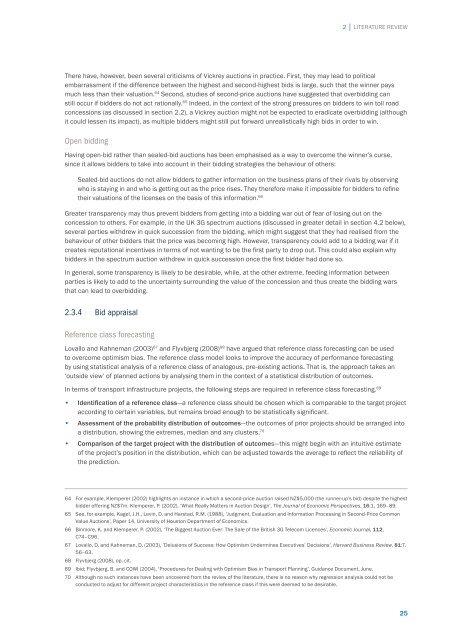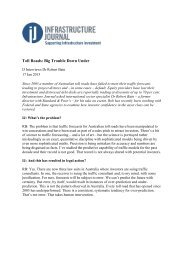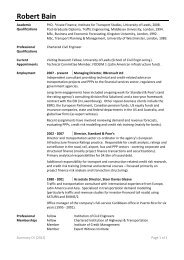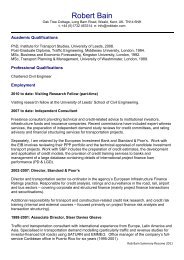Disincentivising overbidding for toll road concessions
Disincentivising overbidding for toll road concessions
Disincentivising overbidding for toll road concessions
- No tags were found...
You also want an ePaper? Increase the reach of your titles
YUMPU automatically turns print PDFs into web optimized ePapers that Google loves.
2 │ LITERATURE REVIEW<br />
There have, however, been several criticisms of Vickrey auctions in practice. First, they may lead to political<br />
embarrassment if the difference between the highest and second-highest bids is large, such that the winner pays<br />
much less than their valuation. 64 Second, studies of second-price auctions have suggested that <strong>overbidding</strong> can<br />
still occur if bidders do not act rationally. 65 Indeed, in the context of the strong pressures on bidders to win <strong>toll</strong> <strong>road</strong><br />
<strong>concessions</strong> (as discussed in section 2.2), a Vickrey auction might not be expected to eradicate <strong>overbidding</strong> (although<br />
it could lessen its impact), as multiple bidders might still put <strong>for</strong>ward unrealistically high bids in order to win.<br />
Open bidding<br />
Having open-bid rather than sealed-bid auctions has been emphasised as a way to overcome the winner’s curse,<br />
since it allows bidders to take into account in their bidding strategies the behaviour of others:<br />
Sealed-bid auctions do not allow bidders to gather in<strong>for</strong>mation on the business plans of their rivals by observing<br />
who is staying in and who is getting out as the price rises. They there<strong>for</strong>e make it impossible <strong>for</strong> bidders to refine<br />
their valuations of the licenses on the basis of this in<strong>for</strong>mation. 66<br />
Greater transparency may thus prevent bidders from getting into a bidding war out of fear of losing out on the<br />
concession to others. For example, in the UK 3G spectrum auctions (discussed in greater detail in section 4.2 below),<br />
several parties withdrew in quick succession from the bidding, which might suggest that they had realised from the<br />
behaviour of other bidders that the price was becoming high. However, transparency could add to a bidding war if it<br />
creates reputational incentives in terms of not wanting to be the first party to drop out. This could also explain why<br />
bidders in the spectrum auction withdrew in quick succession once the first bidder had done so.<br />
In general, some transparency is likely to be desirable, while, at the other extreme, feeding in<strong>for</strong>mation between<br />
parties is likely to add to the uncertainty surrounding the value of the concession and thus create the bidding wars<br />
that can lead to <strong>overbidding</strong>.<br />
2.3.4 Bid appraisal<br />
Reference class <strong>for</strong>ecasting<br />
Lovallo and Kahneman (2003) 67 and Flyvbjerg (2008) 68 have argued that reference class <strong>for</strong>ecasting can be used<br />
to overcome optimism bias. The reference class model looks to improve the accuracy of per<strong>for</strong>mance <strong>for</strong>ecasting<br />
by using statistical analysis of a reference class of analogous, pre-existing actions. That is, the approach takes an<br />
‘outside view’ of planned actions by analysing them in the context of a statistical distribution of outcomes.<br />
In terms of transport infrastructure projects, the following steps are required in reference class <strong>for</strong>ecasting. 69<br />
••<br />
Identification of a reference class—a reference class should be chosen which is comparable to the target project<br />
according to certain variables, but remains b<strong>road</strong> enough to be statistically significant.<br />
••<br />
Assessment of the probability distribution of outcomes—the outcomes of prior projects should be arranged into<br />
a distribution, showing the extremes, median and any clusters. 70<br />
••<br />
Comparison of the target project with the distribution of outcomes—this might begin with an intuitive estimate<br />
of the project’s position in the distribution, which can be adjusted towards the average to reflect the reliability of<br />
the prediction.<br />
64 For example, Klemperer (2002) highlights an instance in which a second-price auction raised NZ$5,000 (the runner-up’s bid) despite the highest<br />
bidder offering NZ$7m. Klemperer, P. (2002), ‘What Really Matters in Auction Design’, The Journal of Economic Perspectives, 16:1, 169–89.<br />
65 See, <strong>for</strong> example, Kagel, J.H., Levin, D. and Harstad, R.M. (1988), ‘Judgment, Evaluation and In<strong>for</strong>mation Processing in Second-Price Common<br />
Value Auctions’, Paper 14, University of Houston Department of Economics.<br />
66 Binmore, K. and Klemperer, P. (2002), ‘The Biggest Auction Ever: The Sale of the British 3G Telecom Licences’, Economic Journal, 112,<br />
C74–C96.<br />
67 Lovallo, D. and Kahneman, D. (2003), ’Delusions of Success: How Optimism Undermines Executives’ Decisions’, Harvard Business Review, 81:7,<br />
56–63.<br />
68 Flyvbjerg (2008), op. cit.<br />
69 Ibid; Flyvbjerg, B. and COWI (2004), ‘Procedures <strong>for</strong> Dealing with Optimism Bias in Transport Planning’, Guidance Document, June.<br />
70 Although no such instances have been uncovered from the review of the literature, there is no reason why regression analysis could not be<br />
conducted to adjust <strong>for</strong> different project characteristics in the reference class if this were deemed to be desirable.<br />
25






